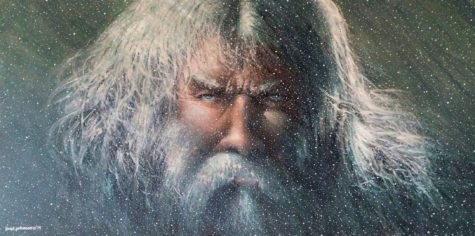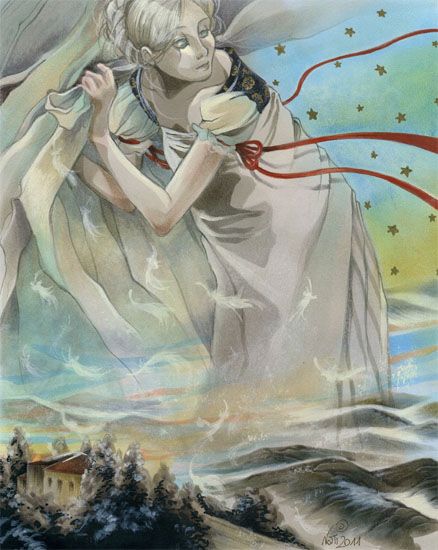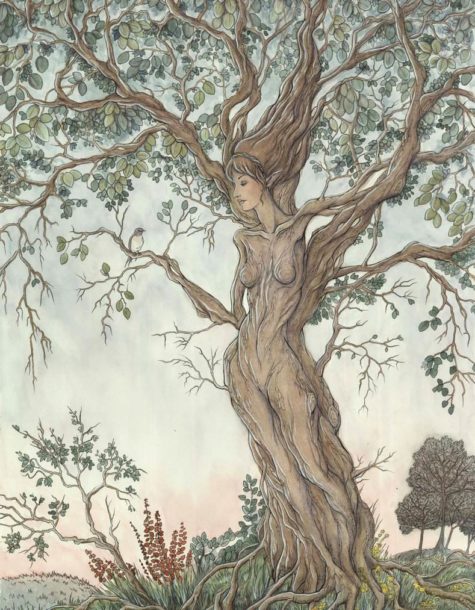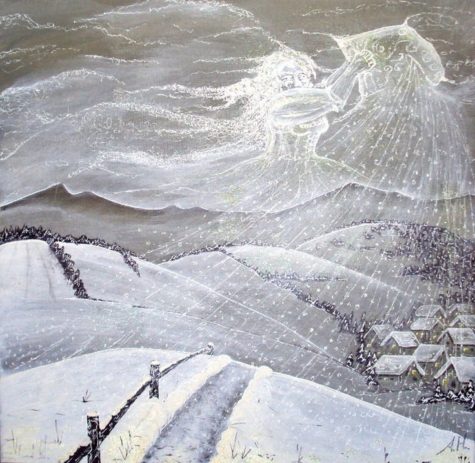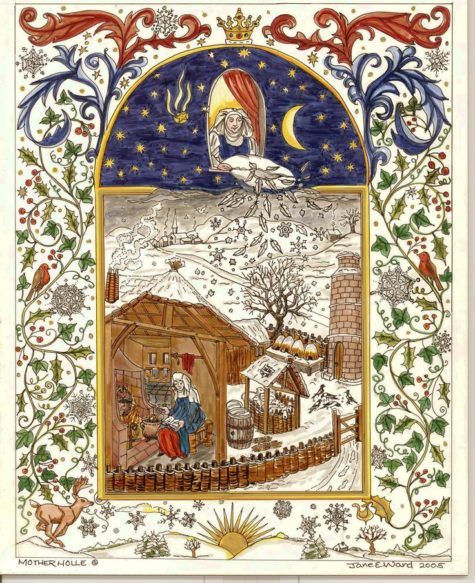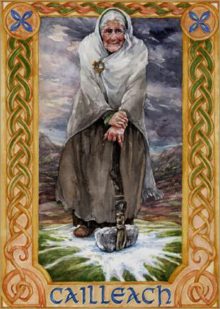Winter Spirits
Holder of the Oath Ring; The Silent One
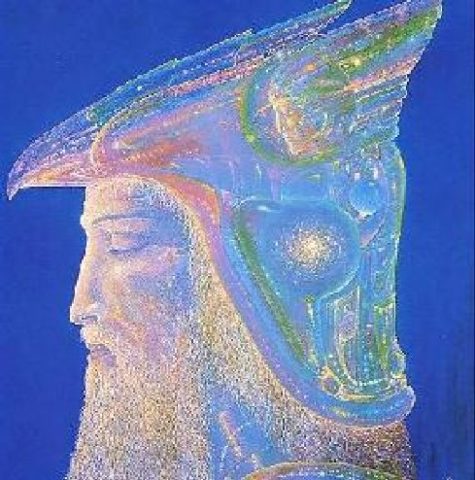
- Also known as: Oller, Ull, Uller, Ullr, Vuldor
- Origin: Norse:
- Rune: Ihwaz
- Tree: Yew (Holler’s home is Ydalir, Yew Tree Valley)
- Favored people: Holler likes the ladies. Skiers love Holler and he seems to love them right back.
Holler is the Lord of Frost and the King of Winter. He is a particularly primordial Norse deity, a mysterious, shadowy spirit. It’s unclear exactly where he sits on the Aesir / Vanir spectrum. Holler may be the son of Sif, the Golden-Tressed One. His father, if any, is unknown, although some suggest that he is of Frost Giant descent.
Holler’s name may be related to “glory.” He seems to have been venerated throughout Scandinavia, the Germanic lands, and the British Isles. According to some myths, when Odin goes wandering, he leaves Holler in charge of Asgard.
Holler is a master archer and hunter and a brilliant skier. Holler skis through the heavens, leaving stars in his wake. He controls the Aurora Borealis. Holler is the lord of justice and dueling. Allegedly invoking his name before a duel brings good luck. When he’s not zipping over the snow on his skis, Holler travels in a ship made from bone.
Holler the Hunter has associations with death. His sacred tree, the yew, is a funerary tree, found in grave yards, not least because of its poisonous berries. Holler may have hunted with poisoned arrows. He may be married to Hulda, weather goddess of birth and death. Like her, he is now associated with the Wild Hunt, and a more negative connotation as the God of Death, Disease and Devastation. It is said that he drags the doomed to his darkest dungeon and delights in dealing out disaster and destruction.
Post-Christianity, many of his more benevolent functions seem to have been transferred to Saint Hubert.
Source: The Encyclopedia of Spirits
- Also known as: Mother Holle, Frau Holle, Hulde
- Origin: Teutonic
- Realms: The sky, underground, mountains, wells
- Constellation: The Milky Way is the street she travels
- Elements: Earth, air, water
- Sacred animals: Wolves, Rabbits
- Color: White, blue
- Spirit Ally: Odin, with whom she sometimes leads the Wild Hunt
- Plants: Holly, elder, juniper, mugwort, flax, Sorcerer’s Violet (Vinca major – sometimes called Frau Holle)
- Sacred Days: The Winter Solstice is Hulda’s feast day. The twelve days between Dec 25 and Jan 6 are sacred to Hulda.
- Offerings: She loves music and dancing.
Manifestations:
A radiantly beautiful blond woman or a fierce old crone. In her guise as Queen of Witches, she has disheveled hair and a wild look.
She may also manifest as a woman when seen from the front but a tree from behind. She may be accompanied by an entourage of torch bearing rabbits who light her way.
About Hulda:
Hulda, a great and ancient goddess of birth and death, presides over a transit station for human souls, a crossroads between life and death. Hulda receives the souls of the newly dead into her realm and releases newborns to live new lives on Earth. Hulda bathes at midday in a fountain from which babies emerge, a well of life.
She was no unknown spirit but a prominent Northern European goddess. Holland is her namesake. Her name may be related to “holy.” Hulda lives in mountain caves and among elder trees, portals to her realm. Her realm may also be accessed via wells. She is sometimes witnessed walking alongside rivers or mountain paths, alone or accompanied by an entourage of rabbits and Fairies. She may be Queen of the Elves.
She plays a prominent part in German folk-lore and superstition. In stormy nights she can be often heard flying through the air, accompanied by weird spirits and witches. On such occasions it is dangerous for ill-doers to be abroad, as they will surely meet with severe punishment; while to the good she frequently appears as a benefactor. Her particular season is winter.
Hulda is a weather spirit. When she shakes her feather bed, it snows on Earth. Rain falls from her laundry rinse water. Fog hovering over a mountain may be smoke from Hulda’s fire. She guards and nurtures all the growing things of the forest. She was a culture-goddess, too, credited with introducing flax to Europe and teaching the art of making linen.
Banished after official conversion to Christianity, people were forbidden to venerate or contact Hulda. Those maintaining that practice were branded witches. Hulda was reclassified as a demon witch-goddess who attacked and harmed children.
She retains dominion over Pagan babies. People were urged to baptize their babies lest they end up in Hulda’s realm. Mother Holle, once so benevolent was transformed into a monster. People warned their children that if they weren’t obedient, Hulda would “get” them.
Vestiges of rituals invoking Hulda’s blessings on baby girls were retained by Ashkenazi Jews (the Hollekreisch), whether because Pagan women found discreet safety in that community rather than convert to Christianity or because Jews perceived Hulda’s resemblance to Lilith. Although rituals survive, many would be shocked and horrified to realize that they invoke a Pagan goddess.
Like Lilith, Hulda is not always so benevolent these days. She is a proud and resolutely Pagan spirit with little patience for hypocrites. Hulda can bestow fertility but she can take it away, too. She has power over storms, raising them as well as soothing them. She can be ambivalent toward people as demonstrated by Mother Holle, the Brothers Grimm fairytail in which she stars.
The theme involves young girls who wander into Hulda’s domain, either inadvertently or deliberately in anticipation of a reward. She rewards the girl who respects her and follows her commands with effort and devotion but causes excrement to rain down upon the lazy, disrespectful girl.
Found in:
- Encyclopaedia of Superstitions, Folklore, and the Occult Sciences
- The Encyclopedia of Spirits
This Neolithic goddess, known variously as the “blue hag”, the “Bear goddess” and “Boar goddess”, “owl faced”, and “ancient woman”, has survived through the ages. Coming from the continent, Her worship spread to the British Isles early after the recession of the glaciers. The proto-Celtic peoples honored Cailleach and blended Her varying aspects, creating images invoking both love and terror. The various names (see below) that Cailleach has been worshipped in lend a clue to Her wide spread worship:
Names: Beare, Béarra, Béirre, Bhéara, Bheare, Bhéirre, Bhérri, Boi, Bui, Cailliaech, Cailliach, Cailleach Beara, Caillech Bherri, Calliagh Birra, Cally Berry, Carline, Digde, Dige, Dirra, Dirri, Duineach, Hag of Beara, Hag of Beare, Mag-Moullach, Mala Liath, Nicnevin, and Scotia,
Titles: Ancient Woman, Bear goddess, Blue Hag, Boar Goddess, Creator of Storms, Crone, Duineach, Goddess of Sovereignty, Many Followers, Old Woman, Owl Faced, and The Popular
The Cailleach Beara is one of the oldest living mythological beings associated with Ireland. According to the ancient stories, she has a conversation with Fintan the Wise and the Hawk of Achill and both agree that she has outlived them, saying ‘Are you the one, the grandmother who ate the apples in the beginning?’ (apples are associated with immortality and are considered the food of the gods)
The Cailleach Beara is ever-renewing and passes through many lifetimes going from old age to youth in a cyclic fashion. She is reputed to have had at least fifty foster children during her ‘lives’. She usually appears as an old woman who asks a hero to sleep with her, if the hero agrees to sleep with the old hag she then transforms into a beautiful woman.
In Scotland, where she is also known as Beira, Queen of Winter, she is credited with making numerous mountains and large hills, which are said to have been formed when she was striding across the land and accidentally dropped rocks from her apron. In other cases she is said to have built the mountains intentionally, to serve as her stepping stones. She carries a hammer for shaping the hills and valleys, and is said to be the mother of all the goddesses and gods.
She is considered to be the daughter of Grainne, or the Winter Sun. She is affectionately known as ‘Grandmother of the Clanns’ and ‘the Ancestress of the Caledonii Tribe’. The legends of the Caledonii tribe speak of the “Bringer of the Ice Mountains”, the great blue Old Woman of the highlands. Called Cailleach, Cailleach Bheur, Scotia, Carline or Mag-Moullach by the people, She was the Beloved Mountain Giantess who protected the early tribe from harm and nurtured them in Her sacred mountains.
The Cailleach Beara is usually associated with Munster in particular Kerry and Cork. Her grandchildren and great-grandchildren formed the tribes of Kerry and it’s surroundings. And she is considered a goddess of sovereignty giving the kings the right to rule their lands.
Traits and Abilities:
She herds deer. She fights Spring. Her staff freezes the ground.
She is sometimes depicted as an old hag with the teeth of a wild bear and boar’s tusks or else is depicted as a one-eyed giantess who leaps from peak to peak, wielding Her magical white rod and blasting the vegetation with frost. Cailleach’s white rod, or slachdan, made of birch, bramble, willow or broom, is a Druidic rod which gives Her power over the weather and the elements.
Cailleach is also a goddess who governs dreams and inner realities. She is the goddess of the sacred hill, the Sidhe, and the place where we enter into the hidden realm of the Fey and spirit beings. Sacred stones, the bones of the earth, are Her special haunts. Cailleach is connected to the ‘bean sidhe’ or banshee (which means ‘supernatural woman’) who are the wild women of the Fey.
In Scotland, the Cailleachan (‘old women’) were also known as The Storm Hags, and seen as personifications of the elemental powers of nature, especially in a destructive aspect. They were said to be particularly active in raising the windstorms of spring, during the period known as A’ Chailleach.
Là Fhèill Brìghde is the day the Cailleach gathers her firewood for the rest of the winter. Legend has it that if she intends to make the winter last a good while longer, she will make sure the weather on February 1 is bright and sunny, so she can gather plenty of firewood to keep herself warm in the coming months. As a result, people are generally relieved if February 1 is a day of foul weather, as it means the Cailleach is asleep, will soon run out of firewood, and therefore winter is almost over.
On the Isle of Man, where She is known as Caillagh ny Groamagh, the Cailleach is said to have been seen on St. Bride’s day in the form of a gigantic bird, carrying sticks in her beak
On the west coast of Scotland, the Cailleach ushers in winter by washing her great plaid (tartan) in the Whirlpool of Coire Bhreacain (cauldron of the plaid). . This process is said to take three days, during which the roar of the coming tempest is heard as far away as twenty miles inland. When she is finished, her plaid is pure white and snow covers the land.
Cailleach is also the guardian spirit of a number of animals. She is associated with the ancient tradition of herding reindeer. This means that the reindeer (and all deer) are Her cattle; She herds and milks them and often gives them protection from hunters. Swine, wild goats, wild cattle, and wolves are also Her creatures. Cailleach is also a fishing goddess, as well as the guardian of wells and streams.
Related Content:
